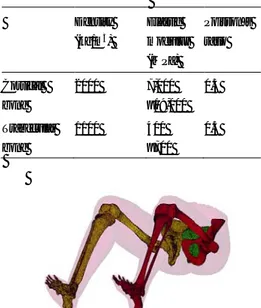한국정밀공학회 2013 년도 춘계학술대회논문집 1. 서론 기술이 점차 발전함에 따라 산업에서 인체의 안전과 건강을 고려한 제품의 설계에 대한 관심이 점차 높아지고 있다. 이에 따라 자동차 업계를 선두로 하여 유한요소 인체모델의 개발이 활발하게 이루어지고 있다. 대표적으로 fig. 1 과 같이 도요타에서 개발한 THUMS model (Total HUman Model for Safety)가 있으며, THUMS 모델은 뼈와 살, 인대, 장기를 요한요소를 이용하여 구현하였다.[1] 이는 자동차 안전도를 평가하기 위한 마네킹 더미를 디지털화한 더미 모델의 연장선상에 있다. 더미 모델에서는 상해 분석법으로 목, 가슴, 머리, 대퇴부의 상해 가능성을 조합하여 치명적인 인체 상해의 평가 가능하다. 반면 개발되고 있는 인체 모델들은 이런 치명적 상해 외에도 인체 내부 장기 손상등과 같은 더미 모델로는 해석 불가능한 골절과 같은 상해 평가가 가능할 것으로 기대되고 있다.
Fig. 1 THUMS model [1]
본 연구에서는 CT(Computerized Tomography) 등의 해부학적 자료를 참조하여 다양한 목적 해석이 가능한 인체 모델을 개발하였다. 본 연구의 목적은 인체 모델을 활용하여 기존 더미 모델에서 평가할 수 없는 치명상 외의 상해와 부상, 의료 시술의 효과 등을 분석하는 것에 있다. 이를 위하여 인체의 골격모델을 세부적으로 모사할 필요가 있다. 인체에서 골격계(skeletal system)는 전신을 지지하는 역할을 하며 크게 해면골(trabecular bone)과 피질골(cortical bone)로 구성되어있다. 피질골은 취성의 단단한 뼈로 골격의 외형을 구성하는 뼈이며 해면골은 다공질 구조로 뼈의 골절에서 에너지를 흡수하는 역할을 한다. 따라서 인체의 부상, 특히 골절을 평가하는데 있어 뼈의 형상과 두께가 큰 영향을 미친다. 따라서 본 연구에서는 해부학적 자료를 참고하여 피질골과 해면골의 두께를 반영한 모델을 구성하고 검증하였다. 2. 유한요소 인체모델 본 연구에서는 전신 인체 모델 개발 계획의 일환으로 하체, 발, 어깨 모델을 개발하였다. 유한요소 골격 모델에 해부학 자료를 참고하여 인대를 부착하였고 피부형상을 반영하여 근육, 지방 등의 연조직을 평균하여 반영한 살을 모델링 하였다. 인체 모델의 물성치는 Yamada, H.등의 문헌을 참조하여 적용하였다.[2,3] 모델에 사용된 물성은 Table 1 과 같다. 살(soft tissue)의 경우 밀도는 기존 인체 모델 연구 등을 참고하고 전체 모델의 질량을 고려하여 유추한 값을 반영하였다. 이를 통하여 완성된 인체 모델은 Fig. 2 와 같다.
유한요소 인체모델과 생체역학적 응용
On a Finite Element Human Model
and its Biomechanical Applications
*#채수원1, 박상백2, 이해아2, 김수민2, 오은경2
*#S.W. Chae(swchae@korea.ac.kr)1, S. B. Park2 , H. A. Lee2 , S. M. Kim2 , E. K. Oh2 1고려대학교 기계공학부, 2고려대학교 대학원 기계공학과
Key words : FE human model, Biomechanics, Low extremity
한국정밀공학회 2013 년도 춘계학술대회논문집
Table 1 Material properties of human model Density (kg/m3) Elastic modulus (MPa) Poisson’s ratio Cortical bone 2000 7,000 ~19,000 0.3 Trabecular bone 1100 400 ~700 0.3
Fig. 2 Finite element model of human low extremity 3. 인체모델의 검증
모델의 검증은 선행 연구들을 참고하여 진행했으며 본 논문에서는 대표적으로 경골과 비골의 3 점 굽힘 시험을 소개하고자 한다. 이는 Fig. 3 과 같이 Costin Untaroiou 의 논문을 참고하여 진행하였다.[4]
Fig. 3 Configuration of 3-point bending simulation Fig.3 테스트 시뮬레이션은 뼈의 양 끝단을 지지하는 서포터와 뼈에 충격을 가하기 위한 임팩터(impactor)로 구성된다. 임팩터의 초기 속도는 아래방향으로 2.1m/s 로 설정하였고 참고 문헌과 동일한 위치에서의 변형률을 측정하였으며 결과는 fig. 4 와 같다. 임팩터의 변위에 대한 변형률을 나타낸 것으로 선행 사체 실험과 유사한 거동을 보임을 확인할 수 있다.
Fig. 4 Tibia maximum principal strain curve 4. 결론 본 연구에서는 해면골과 피질골의 두께, 밀도를 고려하여 하체, 발, 어깨 유한요소 인체모델을 개발하고 검증하였다. 본 연구에서 개발한 인체 모델은 자동차 충돌 상황에서 골절과 같은 부상을 예측, 의료 시술의 안전성 평가와 같은 다양한 목적의 시뮬레이션에 사용할 수 있을 것으로 기대된다. 후기 이 논문은 2012 년도 정부(교육과학기술부)의 재원으로 한국연구재단의 지원을 받아 수행된 기초연구사업임(No. 2012-0000790) 참고문헌
1. Oshita, F., Omori, K., Nakahira, Y., Mike, K., “Development of a Finite Element Model of the Human Body”, 7th International LS-Dyna User conference, 2002
2. Ymada, H., “Strength of Biological Materials”, The Williams & Wilkins Co., 1970
3. Cheung, J.T., Zhang, M., “An Effect of Achilles Tendon Loading on Plantar Fascia Tension in the Standing Foot”, Clinical Biomechanics, 21(2), 194-203, 2006
4. Untaroiu, C., Darvish, K., Crandall, J., Deng, B.,and Wang J.T., 2004, “Development and Validation of a Finite Element Model of the Lower Limb”, IMECE 2004-61583, 2004 ASME Congress.
